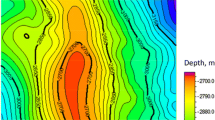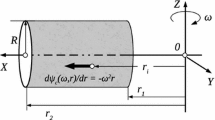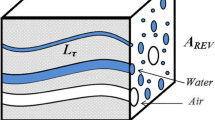Abstract
Propagation and upscaling of water saturation in a geological model are crucial in reservoir evaluation and volumetric calculations. Upscaling of saturation in heterogeneous carbonate reservoirs poses significant problems due to extensive lateral variations in reservoir properties. In this study, a new approach was developed for 3D saturation height modeling based on the relationship of pore throat size distribution (PTSD) with porosity and permeability via the Winland equation. An existing capillary pressure model developed based on fractal theory was implemented to model the capillary pressure measurements in various carbonate core plug samples. The saturations predicted by the proposed model were cross-checked against the saturations derived from petrophysical logs. The results were also compared with some of the most widely applied saturation height models, including the J-Function, Equivalent Radius, Brooks–Corey, and Thomeer’s approach. The predicted saturations from the PTSD method agreed well with the log data, providing superior and more reasonable results compared to other methodologies. The PTSD model was able to capture successfully the reservoir dynamics and it correlated reasonably the saturation trends with height in all the drilled wells and over the entire reservoir.












Similar content being viewed by others
Notes
1 mD = 1millidarcy = 0.986923 × 10−15 m2.
References
Al-Otaibi, M. H., Khamatdinov, R. A., Al-Khaldi, N. A., Abdelrahim, R. K., & Bouaouaja, M. T. (2012). Water Saturation Modeling in Khafji Carbonate Reservoir. Abu Dhabi International Petroleum Conference and Exhibition. Society of Petroleum Engineers, Abu Dhabi, UAE (p. 8.) https://doi.org/10.2118/161427-MS
Al Waili, I. H. (2009). Developing Generalised Capillary Pressure Curves and Saturation Height Function for Shuaiba Carbonate Reservoirs in Field A. SPE Annual Technical Conference and Exhibition. Society of Petroleum Engineers, New Orleans, Louisiana (p. 17). https://doi.org/10.2118/136191-STU
Brooks, R. H., & Corey, A. T. (1966). Properties of porous media affecting fluid flow. Journal of the Irrigation and Drainage Division, 92(2), 61–90.
Buiting, J. J. (2007). Fully Upscaled Saturation-Height Functions for Reservoir Modeling based on Thomeer's Method for Analyzing Capillary Pressure Measurements. SPE Middle East Oil and Gas Show and Conference. Society of Petroleum Engineers, Manama, Bahrain (p. 14). https://doi.org/10.2118/105139-MS
Buiting, J. J. (2011). Upscaling Saturation-Height Technology for Arab Carbonates for Improved Transition-Zone Characterization. SPE Reservoir Evaluation & Engineering, 14(01), 11–24.
Chudi, O., Simon, R., & Omobude, O. A. (2010). Saturation Modelling in a Geological Complex Clastic Reservoir Using Log Derived Saturation Height Function: A Case Study of the E2 Reservoir, Era Eko Field in the Niger Delta. Nigeria Annual International Conference and Exhibition. Society of Petroleum Engineers, Tinapa - Calabar, Nigeria (p. 8). https://doi.org/10.2118/140635-MS
Corey, A. T. (1954). The interrelation between gas and oil relative permeabilities. Producers Monthly, 19(1), 38–41.
Cuddy, S., Allinson, G., & Steele, R. (1993). A Simple, Convincing Model For Calculating Water Saturations In Southern North Sea Gas Fields. SPWLA 34th Annual Logging Symposium. Society of Petrophysicists and Well-Log Analysts, Calgary, Alberta (p. 17).
Engstrom, F., & Olie, M. (1995). A New Method to Normalize Capillary Pressure Curves. SCA Conference, 9535.
Faramarzi-Palangar, M., & Mirzaei-Paiaman, A. (2021). Investigating dynamic rock quality in two-phase flow systems using TEM-function: A comparative study of different rock typing indices. Petroleum Research, 6(1), 16–25.
Faramarzi Palangar, M., Sedaee, B., & Emami Niri, M. (2021). A further investigation on the application of critical pore size as an approach for reservoir rock typing. Journal of Energy Resources Technology, 143(11), 112901-1-13.
Harrison, B., & Jing, X. D. (2001). Saturation Height Methods and Their Impact on Volumetric Hydrocarbon in Place Estimates. SPE Annual Technical Conference and Exhibition. Society of Petroleum Engineers, New Orleans, Louisiana (p. 12). https://doi.org/10.2118/71326-MS
Hu, Y., Yu, X., Chen, G., & Li, S. (2012). Classification of the average capillary pressure function and its application in calculating fluid saturation. Petroleum Exploration and Development, 39(6), 778–784.
Johnson, A. (1987). Permeability Averaged Capillary Data: A Supplement To Log Analysis In Field Studies. SPWLA 28th Annual Logging Symposium. Society of Petrophysicists and Well-Log Analysts, London, England (p. 20).
Kolodzie, S., Jr. (1980). Analysis Of Pore Throat Size And Use Of The Waxman-Smits Equation To Determine Ooip In Spindle Field, Colorado. SPE Annual Technical Conference and Exhibition.
Kumar, R., Cherukupalli, P. K., Lohar, B. L., & Chandra, D. (2002). Saturation Modeling in a Multilayered Carbonate Reservoir Using Log-Derived Saturation-Height Function. SPE/DOE Improved Oil Recovery Symposium. Society of Petroleum Engineers, Tulsa, Oklahoma (p. 8). https://doi.org/10.2118/75213-MS
Lalicata, J., Tanis, E. A., Reed, D. A., & Zannitto, P. J. (2012). A Saturation Height Function Model Derived From Capillary Pressure, Lower Etchegoin/Williamson Reservoir, Lost Hills Field. SPE Western Regional Meeting. Society of Petroleum Engineers, Bakersfield, California, USA (p. 9). https://doi.org/10.2118/153594-MS
Leverett, M. C. (1941). Capillary Behavior in Porous Solids. Transactions of the AIME, 142(01), 152–169.
Li, K. (2010). More general capillary pressure and relative permeability models from fractal geometry. Journal of Contaminant Hydrology, 111(1), 13–24.
Li, K., & Horne, R. N. (2003). Fractal characterization of the geysers rock. Proceedings of the GRC 2003 annual meeting.
Li, K., & Horne, R. N. (2006). Comparison of methods to calculate relative permeability from capillary pressure in consolidated water-wet porous media. Water Resources Research, 42, W06405. https://doi.org/10.1029/2005WR004482
Lian, P. Q., Tan, X. Q., Ma, C. Y., Feng, R. Q., & Gao, H. M. (2016). Saturation modeling in a carbonate reservoir using capillary pressure based saturation height function: A case study of the Svk reservoir in the Y Field. Journal of Petroleum Exploration and Production Technology, 6(1), 73–84.
Pittman, E. D. (1992). Relationship of porosity and permeability to various parameters derived from mercury injection-capillary pressure curves for sandstone. AAPG Bulletin, United States.
Rezaee, M. R., Jafari, A., & Kazemzadeh, E. (2006). Relationships between permeability, porosity and pore throat size in carbonate rocks using regression analysis and neural networks. Journal of Geophysics and Engineering, 3(4), 370–376.
Rostami, S., Rashidi, F., & Safari, H. (2019). Prediction of oil-water relative permeability in sandstone and carbonate reservoir rocks using the CSA-LSSVM algorithm. Journal of Petroleum Science and Engineering, 173, 170–186.
Rudyk, S., & Al-Lamki, A. (2015). Saturation-Height Model of Omani deep tight gas reservoir. Journal of Natural Gas Science and Engineering, 27, 1821–1833.
Seth, K., Beales, V., Kawasaki, A., & Namba, T. (2013). Saturation Height Function in a Field Under Imbibition: A Case Study. SPE Asia Pacific Oil and Gas Conference and Exhibition. Society of Petroleum Engineers, Jakarta, Indonesia (p. 14). https://doi.org/10.2118/165880-MS
Skelt, C. (1996). A Relationship between height, saturation, permeability and porosity. 58th EAGE Conference and Exhibition
Skelt, C., & Harrison, B. (1995). An Integrated Approach To Saturation Height Analysis. SPWLA 36th Annual Logging Symposium, Paris, France (p. 10).
Sohrabi, M., Jamiolahmady, M., & Tafat, M. (2007). Estimation of Saturation Height Function Using Capillary Pressure by Different Approaches. EUROPEC/EAGE Conference and Exhibition, London, U.K. https://doi.org/10.2118/107142-MS
Thomeer, J. H. M. (1960). Introduction of a Pore Geometrical Factor Defined by the Capillary Pressure Curve. Journal of Petroleum Technology, 12(03), 73–77.
Author information
Authors and Affiliations
Corresponding author
Ethics declarations
Conflict of Interest
The authors have no relevant financial or non-financial interests to disclose.
Rights and permissions
About this article
Cite this article
Safari, H., Faramarzi-Palangar, M., Hashemi, S.M.H. et al. A New Approach to 3D Saturation Height Modeling by Coupling a Capillary Pressure Model with Pore Throat Size Distribution. Nat Resour Res 31, 1045–1059 (2022). https://doi.org/10.1007/s11053-022-10012-3
Received:
Accepted:
Published:
Issue Date:
DOI: https://doi.org/10.1007/s11053-022-10012-3




